
Training
(the Horse and the Rider)
"The
one great precept and practice in using a horse is this, never deal with him
when you are in a fit of passion."
—Xenophon,
The Art Of Horsemanship, 400 BC
I probably will not use sketches and such of how to ride at this point. I once read a book that does not show "a 'correct seat' because too much harm can result from over-emphasizing an ideal in purely graphic depiction." I quite agree; however, I don't know what I may decide to do in the future.

It takes seven years to train a Lipizzaner to perfection in only one or two airs, and twelve years are considered necessary to train a man before he reaches the height of his art and his ability to ride a perfectly schooled Lipizzaner. It may take twenty years before one is regarded as an efficient and competent judge of in-hand young stock, hunter riding classes, dressage or coaching teams. Similarly, you may require thirty years of painstaking study in several languages before you have learnt enough to pass on information by means of lectures or the written word.
____________________________________________________________________________________
The horse is
useful to man because of its tendency to move forward when urged to do so--its
"excitability to motion." Equally important, the horse can be educated to
respond in highly controlled ways to the urgings of its rider or driver.
As directed, it will move fast or slow, turn this way or that, step in different
gaits, jump over obstacles, etc. The primary means of controlling a horse
is a bit which is placed crosswise in the horse's mouth and to which reins are
attached. A rider or driver manipulates the reins so as to exert pressures
on the bit and the horse responds to these pressures as it has been trained to
do. A rider also uses his body to control the horse, through leg pressures
and shifts of weight. The modern horse, then, is foremost an animal to be
ridden (or driven). This aptitude, simply expressed in Latin, provided its
scientific name, Equus caballus.
____________________________________________________________________________________
Intelligence (of the Horse)
The question of
intelligence applies no less to the horse than to any other animal. How
much, if anything, it "knows" remains a matter for scientific
investigation. It is certain, however, that the sensory system of the
horse supplies it with much information. Its sight is extremely keen, with
such a wide angle of vision that it can see almost straight behind.
Extraordinary, too, are its hearing and smell, its reflexes and motor
coordination. In addition, the horse has remarkable memory powers.
Like the famous Lipizzan
stallions of the Spanish Riding
School of Vienna, it can be trained to perform involved routines. Like the
cutting horse of the Western range, it can learn to anticipate and out-maneuver
the dodgings of a runaway steer. Its excellent memory can be a liability,
too, for any reminder of a bad scare can cause a horse to react violently.
By nature, the horse is timid. A vicious horse is
either a quirk of nature or the product of mishandling. The stallion's
tendency to aggressive, even hostile, behavior proceeds from his nature and
function as a sire, and is not a cause of concern to experienced horsemen.
Some types of horses, it is true, are less good-natured than others and require
a firmer hand in training and handling.
Thus, the personality of any individual horse is an amalgam
of several influences: his breed characteristics, the treatment he
receives, and his individual make-up. A horse may be high-strung or
nonchalant, "giving" or laggard, quick or slow to learn. He has
enough intelligence to be useful to man in many different ways, but not enough
to realize that he has the advantage in physical strength.
____________________________________________________________________________________
Riding
A horse has to be
carefully prepared before it is ready to be ridden. This is known as
"breaking" and "schooling." The horse has to get used
to having a rider on its back, and must learn to obey commands. A horse
can be broken for riding when it is three years old, and will have an active
life until it is 20, if well cared for. (Horses normally live for 25 to 30
years.)
A rider has just as much to learn as a horse does. He
must learn to sit so that the horse is well-balanced and can move freely.
He must also learn to give the horse signals it can understand.
If you want to learn to ride, find a riding school that is
approved, so you can be sure your teacher is a good one. You should be
given a quiet, well-schooled horse or pony to begin on.
These are the aids a rider uses to
control his horse:
Hands: These hold the reins which control the bit. The
bit lies on a sensitive part of the horse's jaw, so you must keep a steady but
gentle contact with the bit. Use your hands to slow your horse down, and
to turn it to the right or left.
Legs: Use your lower leg and heel to make your horse move
forward, and turn properly (bending its spine). Your legs should be close
to the horse's body. Your heels should be pushed down. If the horse
moves suddenly, try to keep your body relaxed.
Body: Body weight can be used to drive the horse
forward. If you want to slow down, let your weight sink into the
saddle. The horse will easily keep its balance if your seat is
proper. The legs and reins are all that is needed to make the horse change
direction.
Voice: Horses have very sharp hearing, and can learn to
recognize many sounds. To encourage your horse to move forward if it
hesitates, click your tongue. A slow, quiet "Whoa," used
with the proper seat and rein movement, will slow it down. Never scream or
shout near a horse. This will frighten it and it may bolt.
____________________________________________________________________________________
A rider is not necessarily
a horseman. He may be adequate at the different paces, remain
"put" over
moderate fences and be capable of making quiet horses comply with his
wishes. But if he is not "at one" with his mount, both physically and
mentally, if he does not share that indescribable partnership, possible between
man and horse, and never feels the mutual confidence that enables them to
"rise
to the occasion" together, then he is not a horseman. It takes time, and
intuition, but to be a good horseman is to enjoy the ultimate heights of riding.
There are many different methods of riding, each evolved for
a different purpose. The jockey, with very short leathers, seat far
forward and clear of the saddle, is attuned to the speed of the race
horse. The show-jumper sits deep in order to thrust his horse toward a
fence with his seat-bones, and then takes the weight off its loins when
airborne. The cowboy's legs are nearly straight, his seat maintained
almost entirely by balance--riding "Western" being the most comfortable
position for long hours in the saddle. The Australian Aborigine is a
superb stockman and usually rides bareback. The Englishman "out
riding"
sits easily, his leathers of a length that is the most comfortable. All
these are different examples of the same thing, each rider sharing the
lightness, rhythm, balance and understanding that makes them horsemen in harmony
with their horses.
The best method of learning to ride is to attend a reputable
riding school, where the standard of teaching and condition of the horses is
known to be good. Saving a few dollars by going to one of the less
reliable schools may result in incorrect or negligible instruction.
Good riding is an art, appearing, to the uninitiated, to
obtain the horse's willing cooperation with the minimum effort. Rider and
horse must be balanced, the horse's weight distributed beneath you, his head
correctly bent to "accept" the bit. Reins are long enough to give a light
contact with his mouth, but short enough for control. Use seat and legs to
keep him up to the bit. Slight pressure with right rein and left leg will
turn him to the right, with opposite aids for turning left. On circles,
use the outside leg further back to prevent the horse's hindquarters from
swinging out.
The good rider is both relaxed and still. He should sit
deep, but light, in the saddle, with thighs and calves providing the grip.
Ankles should be unstiffened, feet facing more or less forward, toes up.
The lower leg increases speed by slight pressure, but otherwise lies close to
the horse's side, without touching. Constant kicking makes the horse
unresponsive. Your seat is "balanced" when you are independent of any
support by the reins and of your horse's movement.
Reins are a means of communication and indication through
your horse's sensitive mouth (hard mouths come with poor riding). Hands
and wrists should be sympathetic, thumbs uppermost and pointing forward, the
fingers "giving" to the horse's mouth like a sponge being squeezed of
water. Do not yank your horse to a halt, but keep your hands still with an
even pressure on the reins, then push him forward onto his bit with your
legs. The schooled horse meets an unyielding surface, "gives," and
slows. Think of him as a tube of toothpaste, your legs supplying the
energy--the paste. You "push him onto his bit" and apply the cap to the
tube--his energy is bottled up between your legs and your hands.
Horses love being talked to, but hate being shouted at.
Your voice is an important "aid," but only raise it when really necessary.
Your horse will learn to "come to call" in the field, and recognize your voice
near the stable with a whinny.
You should learn the rudiments of jumping--walking and
trotting over very low poles--as you learn to ride. This way the idea of
jumping loses any aspect of fear and becomes a natural ingredient of the art of
riding.
Finally, remember that a young horse's natural reaction is to
swerve away from objects that, to him, appear dangerous. Patience and
schooling minimize this tendency, but the good rider is always aware of
it. If your horse indicates shying, use of the rein furthest from the
feared object, backed up with pressure of both legs, helps to keep him
straight. Your voice will reassure and calm him.
There are various
"seats"
in riding, but the General Purpose Seat is the most useful for the ordinary
rider. After mastering walking and trotting, the next step is the
canter. The rider's seat barely comes away from the saddle, and looking
down or leaning forward are incorrect. There must be nothing stiff about
the position, with a supple waist, and shoulders and head "giving" to the rhythm
of the canter. With each increase in pace, the reins are shortened
slightly to maintain contact.
Galloping is a pace of four-time, the horse's fastest speed, and should not be
attempted by beginners until they have achieved an independent sea, and then
only with an obedient horse. At this pace the rider's weight is adjusted
forward, and from just above to just below the knee. The seat comes
slightly out of the saddle, the body inclining forward in balance with the
horse.
____________________________________________________________________________________
Training the Race horse
Training a horse for
"the sport of kings" is a long and painstaking process. When
only a few days old, the foal is fitted with a simple halter and taught the
touch of the human hand. Months later, as a colt, he is bridled and put
through some beginner's paces at the end of a 30-foot line called the longe
(pronounced "lunge"). Jogging in circles around his trainer, he
learns to move well in the various gaits and to respond to commands. When
big enough to carry a man, he is saddled for the first time and taught to walk
with rider. As training progresses, he learns to run and to overcome his
timidity while maintaining proper track deportment. By age two, he has
started rehearsals for real racing, working out at gradually more demanding
paces and being schooled for the starting gate. Very soon he is ready for
his "maiden" race.
The Thoroughbred
breeding industry produces some 15,000
Thoroughbreds annually. Many horsemen are concerned that out of this crop
the only horse capable of winning the Triple Crown since Citation in 1948 has
been the superbly made Secretariat, winner in 1973. (This article is from
a 1974 publication.) The economics of breeding have made it necessary for
owners to start their horses racing as early as possible to regain the many
thousands of dollars spent on purchase price (or sire's stud fee), training,
keep, and registration fees. It may be that performance pressures are
preventing the young Thoroughbreds from maturing properly and realizing their
potential. However, with the breed in the hands of highly devoted
horsemen, its continuing greatness seems assured.
A man
needs someone to believe in him. A horse has this big need, too.
Whether he is bred to race or show-jump or draw a plow, he needs someone who
believes in his power to run or jump or pull.
Outward signs of the special qualities of the Thoroughbred
may not be visible in
colthood. Sometimes the colt is a playboy who resents having to grow
up. He skitters around his pasture, full of wild notions, and when he is
put into training he either throws a tantrum or bobbles along the track from
side to side as if he were catching butterflies.
It is then a colt needs championing, needs someone who senses
strong fiber and spirit underneath the giddiness. This friend is not
always the trainer or owner; sometimes it is the man who rubs, feeds, and waters
him--his groom. How that groom tries to get his thoughts through to owner
and to trainer! Persistently he corners them and so dead earnest is his
talk that the men laugh at the big sounding words and then walk off, pondering
the seeds in them. So the colt gets another chance, and another.
Then one day he pushes against the wind and opens his nostrils to suck it
in. Suddenly he wants to run and he does, and he wins! And
there at his side, ready with soft warm blanket, ready with words of praise,
ready with rub cloths, stands his groom, feeling big in the chest and good.
____________________________________________________________________________________
Training the Standardbred
Training begins with the
first touch of a man's hand, soon after the foal is dropped by its dam. A
halter is placed on its head which it wears during the first months of
life. Only as a yearling is it introduced to the pieces of the harness,
first the bride, then one by one the other straps and fastenings of the
complicated rig. Next the young horse is taught to walk ahead of his
trainer, guided by very long reins. After a week or two of learning to
turn right or left in response to the reins, he is hitched to a cart and jogged,
gently and slowly in early sessions, faster as he adapts. He will be
fitted with several combinations of shoes until his trainer is satisfied that
the perfect combination of shoes and toe weights has been hit upon--one that
will promote an extended stride with perfect balance. A trotter's shoes
weigh eight ounces or so, a pacer's about five.
In his early jogs, the horse develops his gait, gradually
working up to faster times. If he seems ready for the track, the driver
begins to extend him in four-mile jogs climaxed with a brief all-out burst of
speed. As his times get faster, the workouts are reduced to two a
week. By the day of his first real race he will have logged about 700
miles.
Each day at a harness track is a lesson in how to win
races. It begins at sun-up, when the trainer arrives to check his
horses. With assistant and stable hands, the day is planned out.
They spend the morning working out the horses and the afternoon in such jobs as
shoeing their runners and sizing up the competition.
If post-time for the first race is 8:30 P.M., the horses in
the first race are on the track at 6:30 to begin the warm-up process.
Three times is these two hours each horse will be jogged, then returned to the
paddock for sponging and cooling out. First jog is in light harness and
covers five miles, half of that distance at speed. Again, after a
half-hour interval, the horse returns and makes some practice starts, finishing
off with a mile run at a good clip. In his last appearance before the
race, the horse runs another mile at a little less than all-out speed.
This is about 40 minutes before his race. (Between races, the track is
constantly in use by horses making their practice runs.)
In this elaborate warm-up procedure, the horse is worked for
several miles even before he is called upon to give his all. Strenuous as
it seems, the trotter or pacer needs this loosening in order to run in top
form. He is still limbering up in the last moments before being summoned
to the starting gate.
____________________________________________________________________________________
Do Horses Think?
Horses certainly do think
-- to survive in the wild they have had to develop the ability to think
extremely quickly (although their initial "startle" reflex on becoming
aware of dangers such as a predator is more instinct than thinking). Once
they have become aware of a potential danger, they must quickly assess the
situation, and decide whether or not to run away, or just move to keep the
danger outside their personal space.
Some horses seem to show more intelligent thought than
others. For example, some work out quite quickly how to undo their stable
bolts and escape -- a few even learn how to undo the doors of other horses in
the barn and let out the occupants. This requires both planning and
understanding of the outcome of their action.
The ability to look ahead shows high-level thinking ability,
and although horses may not be able to plan and look ahead to the extent that
humans can, they understand time and know that certain things will happen at a
certain time of day, for example feed times. If a horse is thirsty, it has
to think to go to the water source. If it is in a field at feed time, it
shows thinking ability by wandering over to the gate and looking expectantly
(looking ahead) in the direction from which you will come with its feed bucket.
In order, for example, to complete a round of jumps, the
horse has to concentrate quite hard, thinking about the various aids its rider
is giving it and what they mean -- more impulsion, slow down, turn here -- and
it has to realize that the jump its rider has aimed it at is the one it is
required to clear. It then has to gauge its own strides, or perhaps
regulate them in accordance with its rider's instructions, and take off into the
air in the right place. Only the horse itself can decide, by thinking
quickly, just how high to propel itself into the air. This takes
considerable judgement, even with experience and practice, and cannot be done
without clear thought.
Reasoning Power
It is often said that
horses have no reasoning power, reasoning being the ability to think out a
problem or situation and overcome it. Many experienced and sensitive
horsepeople deny this, knowing from their own experience that horses can
solve problems. In one informal experiment, horses were given feeds in
buckets with loose lids which they had to remove before they could eat.
Most of the horses clearly considered the situation and by various means removed
the lids calmly. Only a few bashed frustratedly at the buckets, showing no
ability to think through the problem.
In another incident, a mare was caught by one hind leg in a
loose wire fence. She was seen to turn her head and look for several
seconds at the loop of wire round her leg. She then raised her other hind
leg, felt the wire carefully with her (shod) hoof, stepped on the loop pressing
it down to the ground and freed her trapped leg. This is an obvious
example of clear thought and reasoning power.
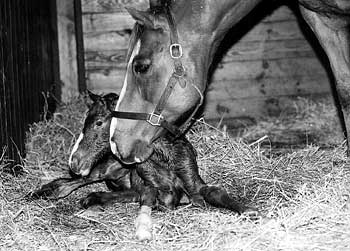
Mares and foals in domesticity are usually weaned earlier than would happen in the wild. If they are reunited, they will recognize each other.
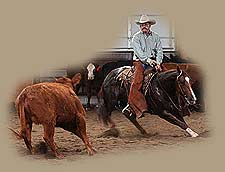
Horses that work with cattle have to be very quick thinking to anticipate the direction the steer or calf will take, and to react instantly.
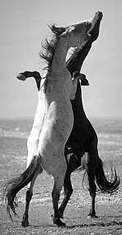
A stallion rears up to intimidate a rival, often lashing out with its front feet. Horses also rear up in play.
Reacting to a Threat
A horse confronted by
something frightening or potentially dangerous will analyze the threat and
respond according to the perceived seriousness of the danger. Initially it
will show the "startle response" -- it will raise its head, prick up
its ears and point them forward, flare its nostrils to take in potentially
informative smells and open its eyes wide to see as much as possible. Its
body will be tense and its hind legs will come slightly more forward under the
body ready to take its weight if the danger is such that it decides to wheel
round and gallop off to safety.
If in the case, for example, of an intruder, the horse
decides to stand its ground, it will probably thrust its head forward
aggressively, with ears back, nostrils wrinkled up and back and maybe bare its
teeth and open the mouth as a warning of its intention to bite if the
threatening intruder does not retreat. Should the intruder not
retreat, it will threaten more aggressively, moving forward with the expression
described, maybe with head low and neck stretched out, lunging out at the
intruder with its teeth.
If, in the case of a horse intruder, the other horse does not
withdraw, a fight may ensue. Both horses will maintain an angry,
aggressive expression and they will bite at each other anywhere within
reach. Males, in particular, often rear up with flailing forelegs, trying
to come down on to the back of their opponent and get them down onto the ground
where they can be trampled and kicked. They also back into each other,
kicking out rapidly in succession with both hind feet at once. Such
kicking is a more common method of fighting for mares.
____________________________________________________________________________________
How Horses Learn
Survival in the wild is
often dependent on an ability to adapt rapidly to new conditions. Horses
can learn fast if the right training is given.
Horses learn mainly by means of association of ideas.
It has been scientifically and practically proved that if a horse can be made to
associate a particular task, even an unpleasant or frightening one, with
something pleasant he will tolerate it much more readily. For instance, a
horse that does not like being shod will accept it in time if it learns that it
will be fed some favourite tidbits, or have a net of sweet hay to nibble at,
during the process. If you are trying to teach a horse to move over in the
stable, for example by pushing it so that it moves away, and at the same time
saying "over", it soon learns to associate the push with the action
and before long will move over to a slight pressure on its side or just the word
"over". The position of the handler's body is important
too. For example, if you stand directly in front of or behind it when
saying "over", it will not know which way to move.
Horses learn their daily routine quickly and watch the goings
on, listen to the various sounds, and absorb daily happenings. They
quickly associate the rattle of feed buckets with the appearance of feed, for
instance, and the sight of someone carrying their saddle and bridle with work or
going for a hack.
They are also quick to absorb atmosphere and can
differentiate between a pleased, praising or calming tone in the human voice and
a sharp, cross, reprimanding tone, or an urging, encouraging one.
At the
beginning of its training, the horse learns basic commands like "walk
on" and "whoa" on the lunge. Being led by a helper, the
horse is shown what the different sounds mean. Soon it learns the commands
well enough to work mainly from the voice alone.
Keep It Simple
Horses learn short, simple sounds best. Although a stream of words said in a particular tone can convey your feelings--such as calming down or urging on--when you want the horse to perform a particular movement it is best to use short sounds of up to three syllables. As horses recognize the actual sound, the tone and inflection of the voice is very important. Always give commands in the same way so as not to confuse the horse. When you buy a new horse, ask the previous owner to demonstrate the exact way in which he or she gave it commands so you can imitate them, even down to their accent if necessary. If the previous owner asked the horse to "trot on" and you use the long drawn-out command "terr-ot", you cannot blame the horse for not complying.
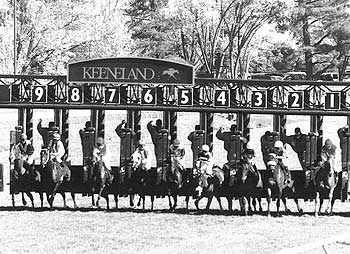
Racehorses are introduced to starting stalls as youngsters by being walked through them, then standing in them; they soon learn that the gates flying open means "gallop".
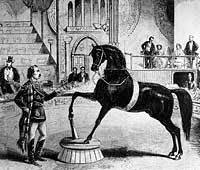
Circus horses, particularly those touring the same route every year, often have to learn new acts regularly, as their audiences will want to see something different each time. However, they never forget their old routines, and can usually be put through a movement after several years' break and perform it faultlessly. Even just the sound of a particular tune can set them off on an old routine.
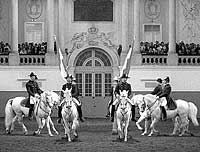
To reach the high standards required at the Spanish Riding School, horses must learn movements that are progressively more difficult, both mentally and physically; they must show increasing understanding of their riders' requirements, and respond to finer and finer aids.
Reward versus Punishment
Horses are easily upset and startled, so it is best to use
reward training rather than punishment training. For instance, when a
horse does something right praise it consistently by always using the words
"good boy" said in the same tone. If it does something wrong,
however, it's best to give no response at all but make your aids clearer, then
praise it when it does get it right. Most horses do want to please.
There are times when a horse may be blatantly naughty or
dominating. In such cases, one sharp smack or crack of the whip
used at the same time as saying the word "no" crossly,
delivered the instant it does wrong, will convey the message that this behavior
is not wanted.
It is essential that both praise and punishment are
administered within one second of the horse's action, otherwise the horse
cannot connect your response with whatever it did and will learn nothing.
It must associate your action with its own, good or bad, in order to learn
whether you are pleased or not. This is the way its brain works and is
essential to the learning process.
Inadvertent Learning
If a horse comes to associate an action with something unpleasant it will not want to do it. For example, if a horse receives a painful jab in the mouth every time it jumps, it will quickly learn that jumping means pain and will start refusing; if it is kicked on the hip every time it is mounted it will soon start to become difficult to mount, having learned that the process is unpleasant.